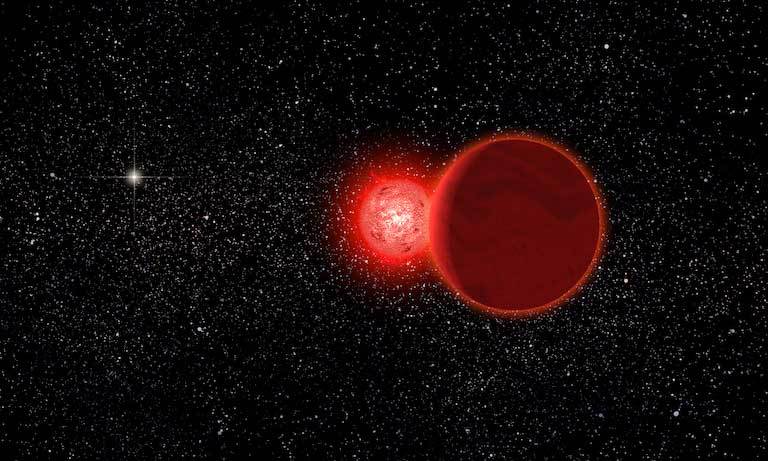February 26, 2019, 09:00 PST
A passing star: our Sun's near miss

Artist's conception of Scholz's star, and its brown dwarf companion (foreground), during a flyby of our solar system some 70,000 years ago. Image credit: Michael Osadciw/University of Rochester
Stars jostling around the galaxy aren’t quite like a cosmic game of pool. But they do have occasional near misses as they speed past each other. Back when spears and stone points were the height of human technology, astronomers say, our solar system had a close encounter of the interstellar kind.
The brief visitor was Scholz’s star, and it might have grazed the outer edge of the solar system’s distant Oort Cloud about 70,000 years ago – carrying its companion, a likely brown dwarf, along for the ride.
It’s unclear whether the near miss was close enough to give objects in the Oort Cloud, our solar system’s halo of dormant comets, a gravitational nudge to fall toward the Sun. But the interstellar trespasser highlights a sometimes-forgotten reality: On long time scales, stars seem to fly around like sparks from a campfire, occasionally coming close enough to disturb each other’s cometary clouds.
Such close passes could have profound implications for exoplanets – planets orbiting other stars – and how they got where they are. At least some of the time, an interloper could become a thief, stripping a star of one or more planets – or vice versa.
Our solar system, too, might have been shaped and sculpted by stellar flybys.
A 2018 study showed that the orbital motions of some of our solar system’s small bodies appear still to bear the imprint of Scholz’s gravitational wake. And some planet-like objects in the Kuiper belt, the collection of rocky and icy bodies past the orbit of Neptune, could have been stolen from another star far earlier – in fact, soon after our Sun was born. Scholz’s flyby could just be the latest in a series.
The discovery of our star-crossed close encounter was almost as random as the event itself.
It started when astronomer Eric Mamajek, deputy program scientist for NASA’s Exoplanet Exploration program, was a professor at the University of Rochester. He took yearly excursions to Santiago, Chile, where he made observations with world-class telescopes.
On one such visit in 2013, a fellow astronomer, Valentin Ivanov, showed him a peculiar result: A newly discovered nearby star with a lengthy catalog designation (later nicknamed for its discoverer, Ralf-Dieter Scholz) seemed almost to be sitting still. Most stars move perceptibly across the sky over the course of a year, as measured in a unit called “arc seconds.” In terms of such “sideways” motion, this one hardly moved at all. Yet the star was only 22 light-years away – quite near to us by galactic standards.
Mamajek knew that could mean only one thing. Either the star was heading straight for us, or it was heading directly away. In this case, the astronomers had obtained measurements of the star’s Doppler shift – the reddening of light if a star is moving away, or a shift toward blue if it’s moving toward us.
“It was screaming away at 80 kilometers per second,” Mamajek recalled. And it didn’t take him long to do the math.
“In less than 15 minutes, we figured out that this star had passed within a light-year of the solar system, 70 or 80 thousand years ago,” he said.
The closest stars to our Sun today are the three in the Alpha Centauri system, about four light-years away. But if there were a star one light-year away, that could very well approach or even intersect with the outermost edge of the Oort Cloud.
Mamajek thinks that Scholz’s star, now known as the star that came closest to our solar system, could eventually lose that title. Extremely precise data from the European Space Agency’s new Gaia space probe will likely reveal more near misses, possibly closer ones. And in any case, another close pass by a star known as GJ 710 is due in about 1.3 million years.
For now, however, Scholz’s keeps its prize.
And might those rock-hammering, spear-shaping early humans have caught a glimpse as the star passed by? Turns out, not terribly likely. Scholz’s star is a red dwarf, the smallest and faintest kind of star we know. Even at its nearest point, about 55,000 astronomical units from our Sun (5.1 trillion miles), Scholz’s star would have been 100 times too dim to be seen with the naked eye.
Still, there’s a chance the visitor made itself known. Red dwarfs are known periodically to emit extremely bright flares.
If the star sent up a flare as it was cruising past our solar system, our cave-dwelling ancestors just might have seen it.
This blog is moderated to remove spam, trolling and solicitations from this government website. We do our best to approve comments as quickly as possible.




